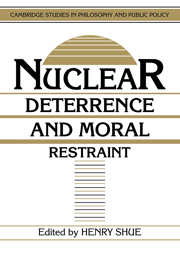Book contents
- Frontmatter
- Contents
- Preface
- Notes on contributors
- Introduction
- 1 Having it both ways: the gradual wrong turn in American strategy
- 2 Finite counterforce
- 3 Deterrence and the moral use of nuclear weapons
- 4 Escaping from the bomb: immoral deterrence and the problem of extrication
- 5 The necessary moral hypocriy of the slide into mutual assured destruction
- 6 Finite deterrence
- 7 Defending Europe: toward a stable conventional deterrent
- 8 The case for deploying strategic defenses
- 9 Morality, the SDI, and limited nuclear war
- Index
7 - Defending Europe: toward a stable conventional deterrent
Published online by Cambridge University Press: 26 January 2010
- Frontmatter
- Contents
- Preface
- Notes on contributors
- Introduction
- 1 Having it both ways: the gradual wrong turn in American strategy
- 2 Finite counterforce
- 3 Deterrence and the moral use of nuclear weapons
- 4 Escaping from the bomb: immoral deterrence and the problem of extrication
- 5 The necessary moral hypocriy of the slide into mutual assured destruction
- 6 Finite deterrence
- 7 Defending Europe: toward a stable conventional deterrent
- 8 The case for deploying strategic defenses
- 9 Morality, the SDI, and limited nuclear war
- Index
Summary
INTRODUCTION
This contribution does not discuss details of nuclear policy. It accepts arguments advocating the conversion of the West's current nuclear forces into a minimum deterrent: The idea of controllable nuclear warfighting options has to be regarded as illusory because of the simple fact that the adversary's reactions are in principle incalculable. The call for a radically restricted role for nuclear forces appears to be very plausible, and consequently a “No First Use” policy should be adopted as a first step toward the broader goal of substantially reducing nuclear firepower.
According to this line of argument, the resulting minimum deterrent should enhance crisis stability by not provoking the adversary (through threats to decapitate him) and by not providing him with lucrative targets (which, given today's state of the art, would suggest sea-basing). Within this context the concept of “finite deterrence” can be seen as a convincingly pragmatic step in the right direction. The INF Treaty and the commitment of the United States and the Soviet Union to START give rise to the hope that the two dominating military powers are already on the right track.
As the role of nuclear deterrence is played down, the question arises what a complementary conventional defense would look like. This conventional posture, of course, should in itself be a strong deterrent and should minimize damage (e.g. the risk of escalation) if deterrence fails. The long-term sustainability of such a defense is a third and equally important requirement.
- Type
- Chapter
- Information
- Nuclear Deterrence and Moral RestraintCritical Choices for American Strategy, pp. 293 - 342Publisher: Cambridge University PressPrint publication year: 1989
- 2
- Cited by



